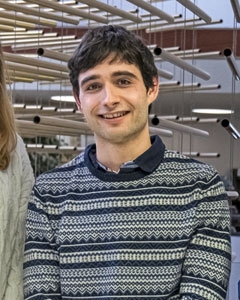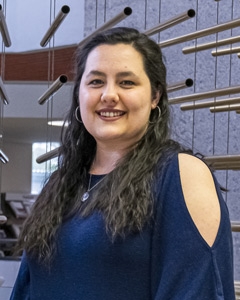PSI: Doktorandentag 2024 des Departements Nukleare Energie und Sicherheit
Das Departement für Nukleare Energie und Sicherheit (NES) am Paul Scherrer Institut (PSI) hat am 23. April seinen jährlichen Doktorandentag (PhD Day) durchgeführt. 27 Doktorandinnen und Doktoranden haben ihre Forschungsarbeiten einer Jury präsentiert. In drei Kategorien wurde jeweils die beste Präsentation mit einem Preis auszeichnet, den das Nuklearforum Schweiz sponsert.
21. Mai 2024

Prof. Andreas Pautz (Leiter NES, links), Maria Marques Fernandes (stellvertretende Leiterin des NES, vorne) und Benedikt Galliker (Nuklearforum Schweiz, rechts) sowie die Preisträgerinnen und Preisträgern (v.l.n.r.) Sevgi Ekin Bayram, Alvaro Ramos Pérez und Jennifer Marie Wilson.
Quelle: PSI
Die Preisträgerinnen und Preisträger

Sevgi Ekin Bayram
Erstes Doktorandenjahr, PSI: NES-Labor für Endlagersicherheit sowie Labor für Nachhaltige Energieträger und Prozesse des Forschungsbereichs Energie und UmweltKinetics and Thermodynamics of Transition Metal Doped calcium-silicate-hydrates (C-S-H)
This work investigates the critical knowledge gap regarding the impact of transition metal cations (like Co, Ni, Cu, Zn) in the blended cements as they influence formation kinetics and thermodynamics of the main hydration phase, calcium-silicate-hydrates (C-S-H), influencing mechanical strength and engineering properties in the cement industry.
Understanding these effects is crucial for optimizing early-stage cement hydration rates and ensuring the long-term durability of hardened cement. The project's findings are expected to advance knowledge in material science, physical chemistry, catalysis, cement science, and environmental research, with broad implications for various scientific and engineering applications.
Characterization methods such as controlled titration method, Inductively Coupled Plasma Optical Emission spectroscopy (ICP-OES), X-Ray Diffraction (XRD), Scanning Electron Microscopy (SEM), Themogravimetric Analysis (TGA) are applied. The investigation also includes kinetic and thermodynamic dynamic modeling to establish a robust database for predicting the stability domains of C-S-H under various conditions.
The preliminary XRD results on Cu doped C-S-H (Cu/C-S-H), suggest that Cu is incorporated in the C-S-H structure, similarly to previous studies on Zn/C-S-H incorporation. The expected outcome has the potential to significantly improve the design of high-performance catalytic materials and enhance cementitious binders.

Alvaro Ramos Pérez
Zweites Doktorandenjahr, PSI: NES-Labor für Reaktorphysik und ThermohydraulikVisualization and characterization of multiphase mass transfer in gas-liquid flows: application to aerosol pool scrubbing
Particle mass transfer processes in multiphase flows are widely present in chemical engineering and energy conversion processes. During a severe accident event with core degradation in a nuclear power plant, aerosol pool scrubbing can be used to capture radioactive particles from the venting of a containment. Despite its fundamental nature and the significant effort of numerous studies in characterizing such processes, accurately validated computational multiphase fluid dynamics predictions of the local particle mass transfer at the bubble scale are still unavailable.
In this study, we developed a new experimental technique based on high-resolution time and space conductivity measurements to visualize hydrodynamics and particle mass transfer in a particle-loaded gas-liquid bubbly flow in a vertical channel. The conductivity measurements are performed with a 1 mm resolution Wire-mesh sensor at 3200 Hz. The injected aerosols are NaCl micrometer diameter particles. The passage of the bubbles is characterized by a signal of lower relative conductivity than the liquid water. From the measured data, we can directly obtain the local value of the void fraction. The size and shape of every single bubble can be measured. Once the aerosol particles are transferred to the liquid phase, they dissolve, and the conductivity signal is proportional to the electrolyte concentration. The mass transfer is visualized in a concentration wake that follows downstream from the bubble. We performed experiments at different aerosol concentrations and particle sizes to assess the effects of the aerosol characteristics on the particle mass transfer.
We obtain a CFD-grade data first-of-its-kind representation of prototypical ellipsoid bubbles and wakes. The sub-scale data can be reconstructed using the available large ensemble of bubbles. The resolution is such that the bubble's geometry can be characterized in detail. The geometry of the reconstructed mass transfer wakes corresponds to the expected momentum flow field behind a blunt body in the subcritical turbulent regime. We suggest a mechanistic description of the heterogenous particle mass transfer based on the contributions of the inertial and impaction particle mass transfer flux from the bubble to the liquid, and the turbulent diffusive and advective mass flux of dissolved aerosols in the liquid phase. A turbulence decomposition analysis approach is included to study the interface oscillations due to flow instabilities and the variability of the mass transfer wake.

Jennifer Marie Wilson
Drittes Doktorandenjahr, PSI: NES-Labor für RadiochemieOnline and Offline Gas-Phase Chromatography of Thallium (Tl) for Nihonium (Nh)
The chemical study of superheavy elements (SHEs; Z ≥ 104) helps us explore the influence of relativistic effects on physico-chemical properties. As relativistic effects roughly scale with Z2, experimentally determined properties are ideal benchmark values for testing full relativistic quantum chemical models. This ultimately enables improved predictions for heavy elements in general. Gas-phase chromatography has been used to investigate the adsorption behavior of superheavy elements and their lighter homologs on different surfaces.
As of now, there has only been three published studies on the chemistry of nihonium (Nh, Z = 113). However, the obtained results of said studies are ambiguous. This prompted the reinvestigation of its lighter homolog, Tl, to fully understand its chemical behavior before investing into another Nh chemistry experiment. Presented here will be the offline thermochromatography studies completed at PSI and two online isothermal chromatography experiments carried out at the accelerator facilities abroad.
Quelle
NES des PSI und Nuklearforum Schweiz